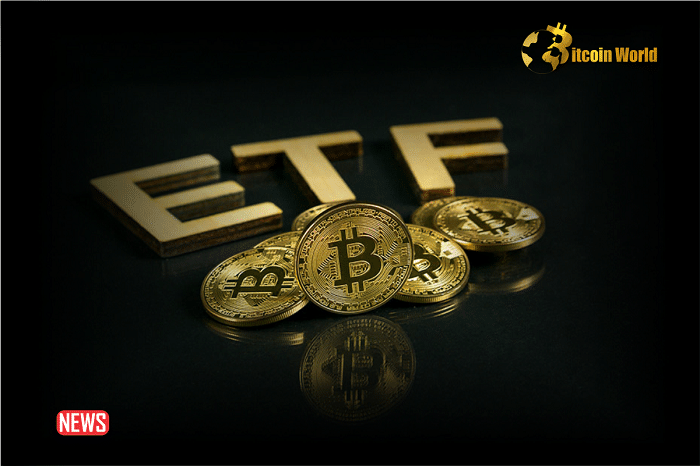Buckle up, crypto enthusiasts! The rollercoaster ride of Bitcoin continues, and with every dip and peak, the market dynamics shift. Recently, Bitcoin experienced a correction after hitting new all-time highs, leaving many wondering what’s next for the king of crypto and the booming Bitcoin Exchange Traded Fund (ETF) market. Enter Ki Young Ju, the CEO of CryptoQuant, a well-respected on-chain analytics firm. He’s dropped some insightful predictions that could signal the next big wave in Bitcoin ETF demand. Let’s dive into what he’s saying and what it could mean for you.
Will Bitcoin ETF Demand Surge Amid Price Drops?
According to a recent statement, Ki Young Ju believes that a potential price correction in Bitcoin could actually trigger a rebound in demand for spot Bitcoin ETFs. This might sound counterintuitive at first – wouldn’t lower prices mean less interest? Not necessarily, especially when we consider the strategic moves of big players in the crypto space.
- Key Prediction: Ki Young Ju forecasts that if the price of Bitcoin continues to decline, we could see a resurgence in demand for spot Bitcoin ETFs.
But what’s the basis for this prediction? Let’s break down the factors at play.
Historical Trends: ETF Demand and Bitcoin Price Levels
Young Ju’s analysis isn’t based on guesswork; it’s rooted in historical data. By examining past net flow trends, CryptoQuant has observed a pattern: demand for Bitcoin ETFs tends to increase when Bitcoin’s price falls to certain levels.
See Also: Bitcoin and Ethereum See Gains As Halving Looms
This suggests that strategic investors, particularly institutional players entering the market through ETFs, are waiting for opportune moments to buy the dip. They see price drops not as a reason to panic, but as a chance to accumulate Bitcoin at a more favorable entry point.
Recent ETF Outflows: A Temporary Setback?
While the long-term outlook might be bullish, recent data from BitMEX Research highlights a short-term trend of negative net flows in spot BTC ETFs. This means that more money has been flowing out of these ETFs than into them recently.
- Grayscale Bitcoin Trust (GBTC) Outflows: A significant contributor to this negative flow is continued outflows from the Grayscale Bitcoin Trust ETF.
- Reduced Inflows Elsewhere: Inflows into other Bitcoin ETFs have also decreased over the past few trading sessions.
Does this contradict Young Ju’s prediction? Not necessarily. Market corrections and short-term fluctuations are common, especially in the volatile crypto space. These outflows could be temporary profit-taking or market adjustments before the next wave of investment.
The $56,000 Level: A Critical Price Point
Here’s where things get really interesting. Young Ju points out that new Bitcoin whales, especially those buying through ETFs, have an estimated on-chain cost basis of around $56,000.
What does this mean?
- Cost Basis as a Buy Signal: This $56,000 level represents the average price at which these new, large-scale investors have accumulated their Bitcoin holdings.
- Anticipated Inflows: If Bitcoin’s price were to fall to or near this $56,000 mark, Young Ju anticipates a substantial surge in inflows into Bitcoin ETFs. Why? Because it would be an opportunity for these whales to increase their positions at or below their average purchase price, further solidifying their investment strategy.
Could Bitcoin Price Dip Further? The 30% Correction Scenario
Adding another layer to his analysis, Young Ju suggests that we could see a further dip in Bitcoin’s price. He notes that market corrections often involve a price drop of around 30%.
Putting this into perspective:
- From Peak to Potential Bottom: If we calculate a 30% correction from Bitcoin’s recent all-time high of $73,750, it brings the potential bottom to approximately $51,000.
- Price Range to Watch: This means the range between $51,000 and $56,000 could be a crucial zone to watch for increased ETF activity and potential price stabilization.
Market Correction Context: Overheated Conditions and Halving Ahead
The recent correction in Bitcoin’s price isn’t happening in a vacuum. Analysts attribute it to overheated market conditions. After a significant bull run, a retracement is often considered healthy and even necessary for sustained growth.
Furthermore, the upcoming Bitcoin halving event in April is a major factor on the horizon. Historically, halvings have been followed by significant price appreciation, but in the short term, the market can experience volatility and adjustments as it anticipates this event.
In Conclusion: Are Bitcoin ETFs the Next Big Catalyst?
Ki Young Ju’s prediction paints an interesting picture for the near future of Bitcoin and Bitcoin ETFs. While short-term outflows might cause some concern, the underlying thesis is compelling: price drops to strategic levels, particularly around $56,000, could act as a catalyst for renewed Bitcoin ETF demand. This is driven by large investors looking to capitalize on price corrections and accumulate more Bitcoin at favorable prices.
As we move closer to the Bitcoin halving and navigate the inherent volatility of the crypto market, keeping an eye on ETF flows and key price levels like $56,000 could provide valuable insights into the next phase of Bitcoin’s journey. Will Young Ju’s prediction come to fruition? Only time will tell, but the data and analysis certainly provide a compelling case.
Disclaimer: The information provided is not trading advice. Bitcoinworld.co.in holds no liability for any investments made based on the information provided on this page. We strongly recommend independent research and/or consultation with a qualified professional before making any investment decisions.
#Binance #WRITE2EARN
Disclaimer: The information provided is not trading advice, Bitcoinworld.co.in holds no liability for any investments made based on the information provided on this page. We strongly recommend independent research and/or consultation with a qualified professional before making any investment decisions.



